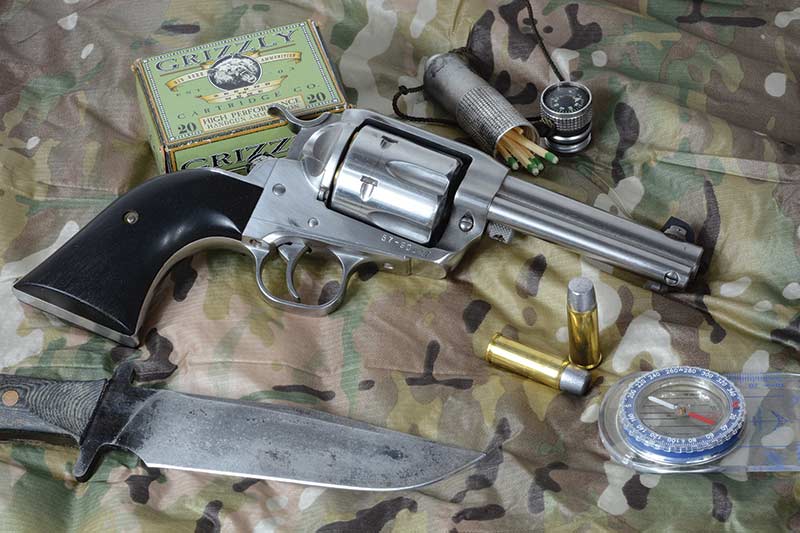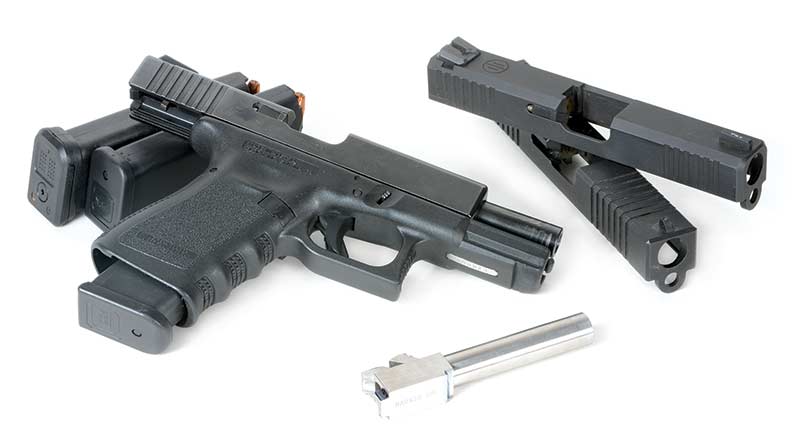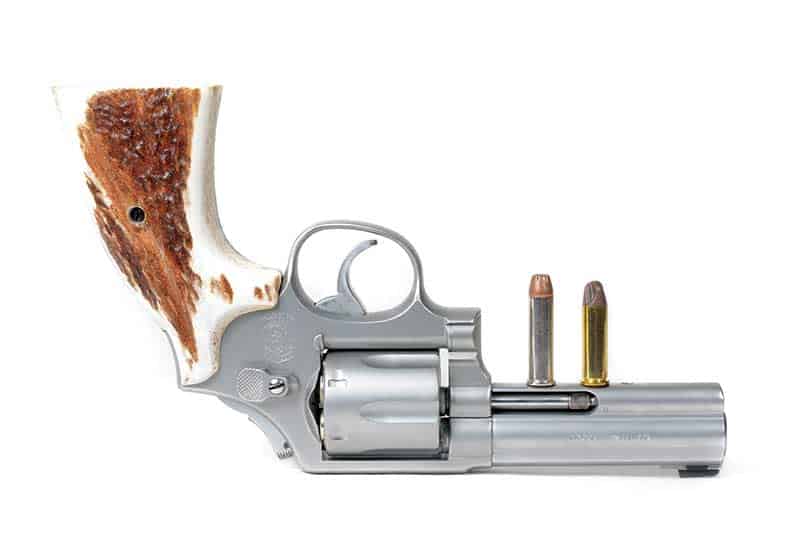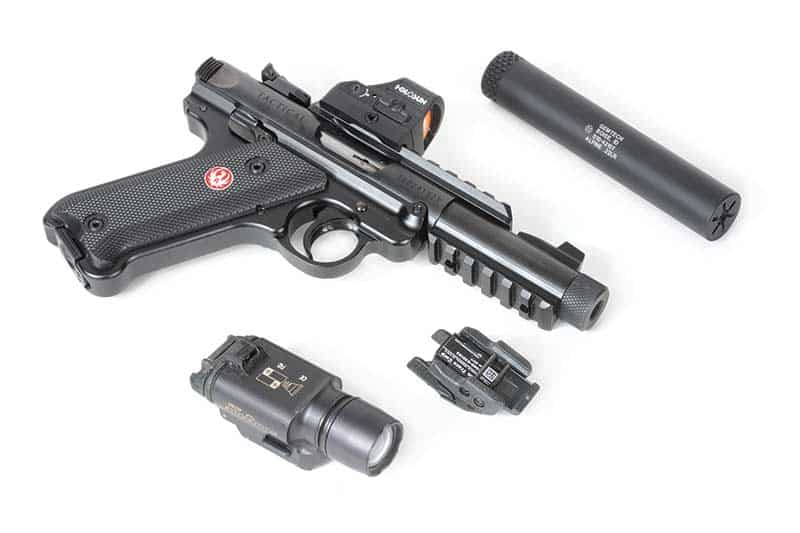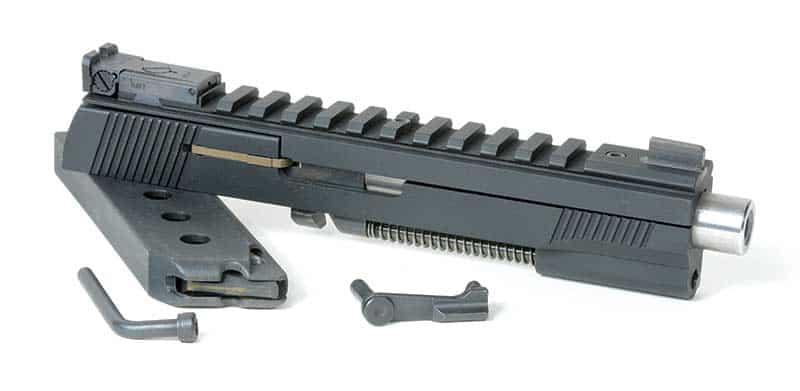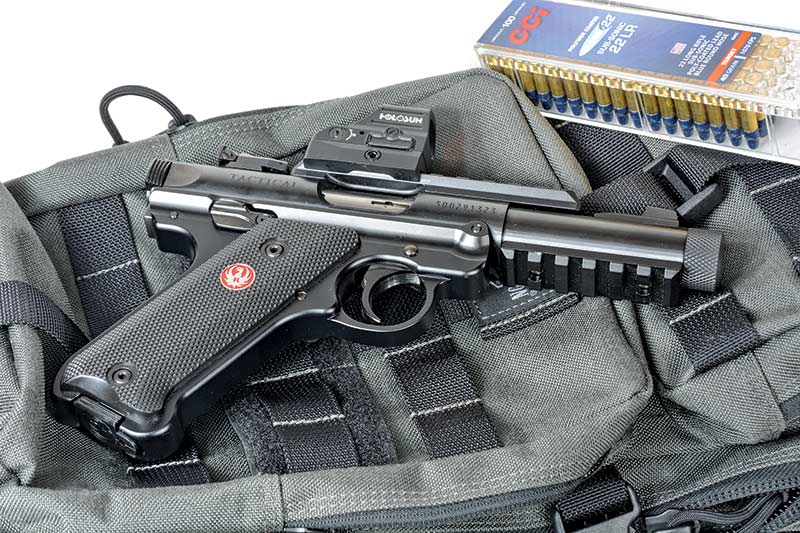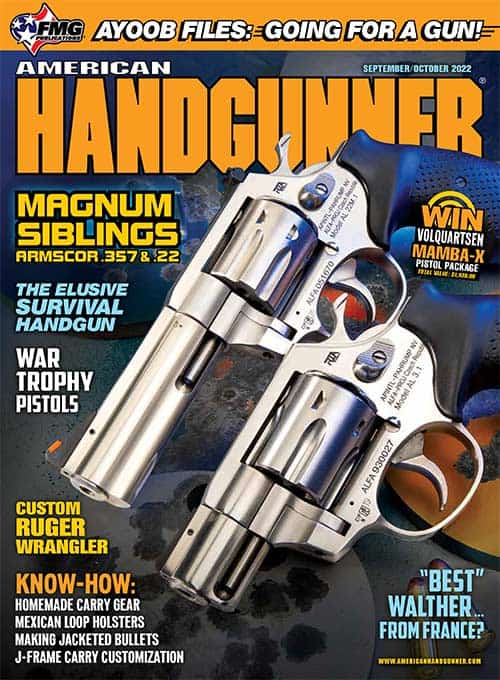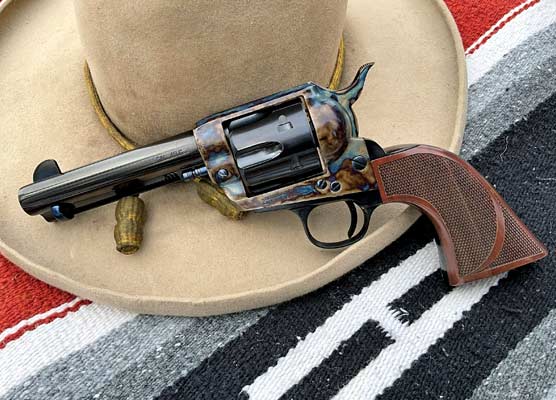One and Done: In Search of the Elusive Survival Handgun
Those of us who grew up in the ’80s remember the survival knife craze of big, fixed blades, usually equipped with saw teeth and hollow handles stocked with all the goodies to capture a boy’s imagination. A standard set of features sticks in my memory: a compass was absolutely required, generally mounted in the butt cap where it would crack easily when you invariably threw the knife at a pine tree, plus a selection of matches, fishing line and hooks, a snare for subsistence trapping of rabbits, elk, ptarmigans in the Arctic wild, etc.
But what of the survival handgun? What features should it have?
This was the central question in an event I recently attended at Gunsite: If you were limited to a single handgun for all expected tasks, what would it be? There’s no universal answer because there’s no unified roster of expected tasks and guns are specific things. Adaptability is desired, but most guns are designed to perform one task well — concealed carry, hunting, target shooting — at the expense of features useful to perform other tasks. So, survival means first determining the event you’re most likely to need to survive and how you are most likely to do so.
Circumstances
While it seems far-fetched at first blush, it doesn’t take long to come up with a list of situations where you could find yourself down to a single pistol. One could include legal restrictions on the number of handguns you can possess in your state or town. History is full of rapidly displaced people who need to leave suddenly with only what they can carry. Ukraine is a fresh example of that, and we’ve seen natural and man-made disasters here that made it a good idea to leave in a hurry with some means of protecting yourself as you go. Most of us are unlikely to find ourselves living in the wilderness for an extended period of time, fed solely by the game we harvest. Still, there are places — Alaska, I’m looking at you — where that’s a very real possibility. Overlanding vehicles sometimes break or get stuck (four-wheel drive doesn’t mean you can’t get stuck, it means you get stuck farther out), bush planes occasionally go down, and, assuming you survive the crash, rescue is not guaranteed, much less that it will be fast.
Wise Choices
So how to pick the pistol? There are plenty of places in the wilderness where ending your life as bear scat is on the table, and while an accurate .22 pistol can be surprisingly effective for hunting, it’s lousy on Kodiaks. On the other hand, that .500 Linebaugh doesn’t leave much squirrel left to cook, and while a brick of .22 fits anywhere, you’re less likely to have a case of Linebaugh on board. Remember, planes have weight limits — something I learned 20 years ago when I had to leave several guns behind for the Cessna 172 I was on to make it safely out of the wilds of Chattanooga. People have weight limits, too: If your adventure could result in a hike many miles back to civilization, being physically able to carry an adequate supply of ammo is a concern.
Think About The Ammo
Indeed, ammo is the serious question: not only carrying it but having it to start with. The ongoing challenge of the last couple of years has been the ability to obtain ammo in a chosen caliber on an ongoing basis. Either in Alaska or daily concealed carry, a gun you can’t practice enough to hit with is a noisemaker. One you can’t feed is a club, so commonly available ammunition is a requirement.
I applaud innovation, and yes, the brand-new 9.81mm Nerdling Special Magnum may have never-before-achieved ballistic performance, but that only matters if there’s enough ammo in circulation to get it when you need it. There’s a paradox here: The offbeat stuff is less likely to be on the shelf, but the popular stuff leaves it faster, so there’s a sweet spot between the two. We all know 9mm, the pistol caliber du jour, has been scarce as hen’s teeth, while even near the peak of the pandemic, I could often still find .45 ACP. Same thing with .223 (gone) and .308 (usually there).
Optics?
It’s not just ammo: Red dot sights continue their migration from modern service rifles to carry pistols and invariably require some kind of battery. As do lasers, lights, etc. While the 123s that power most tactical lights are easy to find, not all optic batteries are: I have an older Trijicon that requires a size I’ve never found on the shelf and had to order online. In a world with supply chain issues, knowing you’ll be able to find batteries for your optic is kind of a big deal and should be a consideration in which optic you choose, if any. And when you buy, buy extra; we’ve all seen how quickly retail sales can be affected by the unexpected or shut down completely.
Reliability
Repair and maintenance are also issues. Most of the currently produced handguns are extremely reliable, but even the guns with the best reputations are mechanical objects that fail intermittently. Parts like magazines and recoil springs wear out. They need to be replaced, so it’s wise to select a platform with common parts availability, especially if you want to guard against a long period of limited resources, which is a sort of survival of its own.
While it’s not typically my choice, this makes the GLOCK 19 a compelling option. The world is awash with them, including more than one size of magazine and parts kits that generally don’t require specialized tools and expert fitting. Whether the caliber meets the challenges you expect to face is for you to decide.
Wheelguns
Revolvers are far more forgiving of ammunition variations than autos, a blessing for those of us who have gotten bad batches of ammo, and the .357 and .44 Magnums’ ability to shoot understudy calibers, such as .38 and .44 Specials, opens up one more ammo stream. They’re also generally more accurate and reliable, but if they break (rarely, but they do), wheelguns are far more complex internally and require skilled gunsmithing to repair, which may include parts that are not available.
The older Colt double-action revolvers are a great example: Marvelous guns, but there is a very small pool of competent pistolsmiths who can rework one, which means there’s not likely to be one in your neighborhood. I love my old Colts dearly, but if I were looking for a gun to beat against rocks on an extended trek, they would not be my first choice.
New Colts are a different ballgame, as are Smiths and www.ruger.com, which are legendary for strength. Single actions are even simpler, with less to break and come in the more powerful chamberings appropriate for big bear defense, for which the commonly available autopistol calibers are generally … suboptimal.
A Gunsite Field Test
Since there is no single answer, I took two pistols to Gunsite: a Novak Colt Rail Gun in .45 ACP accompanied by a Marvel .22 LR conversion and a .22 caliber Ruger MkIV Tactical. In a smallish group of industry professionals, there was an exceedingly broad variety of opinions, all well-reasoned and tailored by each individual’s experience and their expected survival scenario. One thing was universally agreed upon: When it comes to the ammo question, .22 wins hands down. No doubt it suffers in the power department, but it’s the easiest caliber to find and to carry in quantity, which means it will be a longer time before your gun becomes a club.
Conversions
In my view, the .22 conversion is the best of both worlds since there’s still a heavier caliber option, and both the rimfire and the .45 are plenty accurate. My daily carry 1911 averages 1.5″ at 25 yards with JHP and ball, while the Marvel conversions I’ve tested average 1″ at 50, with some brands going into half that — that’s right, one MOA, more than accurate enough to take small game. While there are other configurations available, I chose a Marvel unit with both adjustable sights and a Pic rail, which adds flexibility like the rail on the 1911. I shot it only with irons at Gunsite, where I ran the Scrambler rifle course with some targets out just beyond 100 yards and only missed one target.
Ruger Rimfire
Like the Rail Gun/Marvel combination, Ruger’s MkIV Tactical has rails top and bottom and represents the finest evolution yet of the Mk platform. Gone is the heel magazine release that slowed down reloads on the Standard, MkI and MkII pistols, as well as the thumbnail-splitting takedown lever that lasted through the MkIII, and the simple stud safety lever of yore has been replaced by an ambidextrous thumbpiece. As we’ve come to expect, the muzzle of the 4.4″ barrel is threaded 1/2×28 for a suppressor.
The Ruger is the standard rimfire, and for a good reason: It is accurate and monotonously dependable. Several years ago, I pitted an MkIII against an aftermarket version of the same gun and was surprised to see the average accuracy was absolutely the same: The custom one shot some loads into tighter groups but others less well. What impressed me is even as notoriously inconsistent as .22 ammo is, the Ruger shot everything well, an engineering feat and desirable trait, if you don’t have the luxury of finding your favored brand of ammo all the time.
Accessories
I shot it with a Trijicon RMR borrowed from one of my ARs during the class, which I’ve since replaced with a Holosun 507C green dot (the rail mount comes separately). The 507C boasts some 50,000 hours of battery life, boosted by a top-mounted solar panel and three user-selectable reticle options. I chose the 2 MOA dot, which eliminates the possible sight alignment errors of traditional iron sights and worked beautifully at a distance. Shooting a man-sized steel target at 100 yards is basically a 10-for-10 proposition, mag after mag.
All pistols need a holster, and for that, I reached out to fellow class member Rob Leahy of Simply Rugged Holsters. He provided a low-cut competition-style rig that would clear the optic on the Ruger and a custom-molded one for the unusual top-rail configuration of the Rail Gun/Marvel pistol. While Leahy does some very ornate BBQ-style holsters, the bulk of his work is, as the name suggests, well-made, rugged holsters designed for serious use. Serious enough to survive.
Special thanks to Lew Gosnell, Aimee Grant and the Gunsite Irregulars.
For more info: MarvelPrecision.com, Gunsite.com, Holosun.com, Novaksinc.com, Ruger.com, SimplyRugged.com


